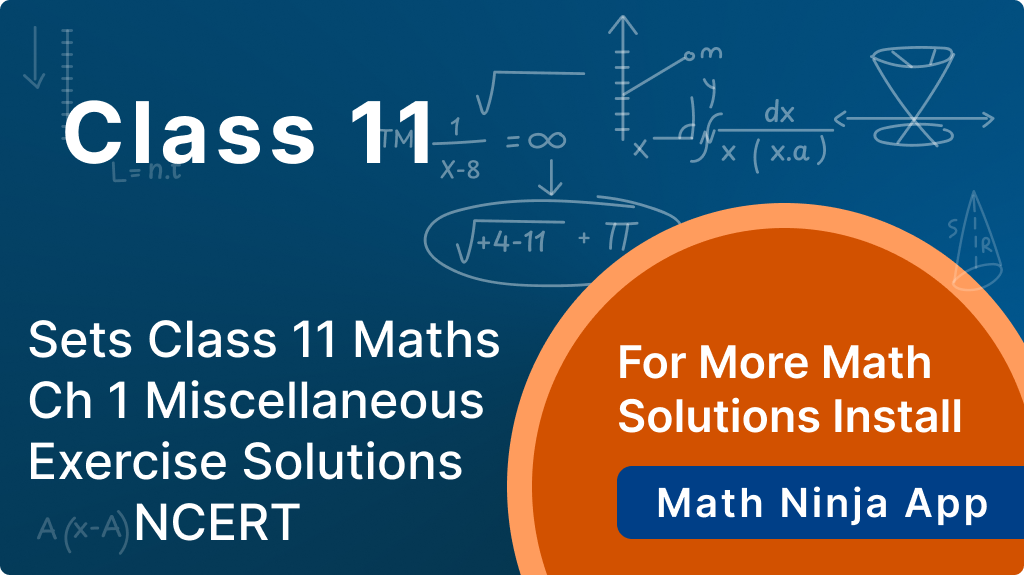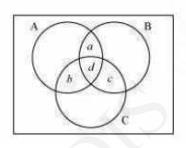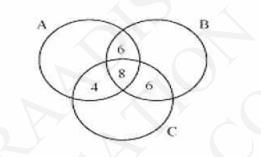Class 11 maths ch 1 miscellaneous exercise solutions | class 11 maths chapter 1 miscellaneous exercise | sets class 11 ncert solutions | ncert solution for class 11 maths chapter 1 | ncert exemplar class 11 maths
Looking for NCERT Class 11 Maths Chapter 1 Miscellaneous Exercise solutions? You’re in the right spot! This section provides complete, step-by-step solutions to all the questions in the Miscellaneous Exercise of Chapter 1 – Sets. These problems combine all key concepts from the chapter, including union, intersection, complements, and Venn diagram-based problems, offering a thorough revision of the entire chapter. Ideal for exam preparation and concept reinforcement, these Class 11 Maths NCERT solutions will help you tackle complex questions with confidence. View or download the solutions now and ace your understanding of sets!

ncert exemplar class 11 maths || ncert solution for class 11 maths chapter 1 || class 11 maths ch 1 miscellaneous exercise solutions || sets class 11 ncert solutions || class 11 maths chapter 1 miscellaneous exercise
Miscellaneous Exercise
\( A=\{x: x \in R \) and \( x \) satisfy \( x 2-8 x+12=0\} \),
\( B=\{2,4,6\}, C=\{2,4,6,8, \ldots\}, D=\{6\} \)
2 and 6 are the only solutions of \( x 2-8 x+12=0 \).
\(\therefore A=\{2,6\}\)
\(B=\{2,4,6\}, C=\{2,4,6,8 \ldots\}, D=\{6\}\)
\(\therefore D \subset A \subset B \subset C\)
Hence, \( \mathrm{A} \subset \mathrm{B}, \mathrm{A} \subset \mathrm{C}, \mathrm{B} \subset \mathrm{C}, \mathrm{D} \subset \mathrm{A}, \mathrm{D} \subset \mathrm{B}, \mathrm{D} \subset \mathrm{C} \)
2. In each of the following, determine whether the statement is true or false. If it is true, prove it. If it is false, give an example:
Let \( \mathrm{A}=\{1,2\} \) and \( \mathrm{B}=\{1,\{1,2\},\{3\}\} \)
Now,
\( 2 \in\{1,2\} \) and \( \{1,2\} \in\{\{3\}, 1,\{1,2\}\} \)
\( \therefore \mathrm{A} \in \mathrm{B} \)
However,
\( 2 \notin \{\{3\}, 1\{1,2\}\} \)
ncert exemplar class 11 maths || ncert solution for class 11 maths chapter 1 || class 11 maths ch 1 miscellaneous exercise solutions || sets class 11 ncert solutions || class 11 maths chapter 1 miscellaneous exercise
Let
\( A=\{2\}, B=\{0,2\} \), and \( C=\{1,\{0,2\}, 3\} \)
As \( \mathrm{A} \subset \mathrm{B} \)
\( B \in C \)
However, \( \mathrm{A} \notin \mathrm{C} \)
Let \( \mathrm{A} \subset \mathrm{B} \) and \( \mathrm{B} \subset \mathrm{C} \).
Let \( x \in \mathrm{A} \)
\(=x \in \mathrm{B}[\mathrm{A} \subset \mathrm{B}]\)
\(=x \in \mathrm{C}[\mathrm{B} \subset \mathrm{C}]\)
\(\therefore \mathrm{A} \subset \mathrm{C}\)
\( A=\{1,2\}, B=\{0,6,8\} \) and \( C=\{0,1,2,6,9\} \)
\( \mathrm{A} \not \subset \mathrm{B} \) and \( \mathrm{B} \not \subset \mathrm{C} \)
Let
Accordingly,
However, \( \mathrm{A} \subset \mathrm{C} \)
Let \( \mathrm{A}=\{3,5,7\} \) and \( \mathrm{B}=\{3,4,6\} \)
Now, \( 5 \in \mathrm{A} \) and \( \mathrm{A} \not \subset \mathrm{B} \)
However, \( 5 \notin \mathrm{B} \)
Let \( \mathrm{A} \subset \mathrm{B} \) and \( x \notin \mathrm{B} \).
To show: \( x \notin \mathrm{A} \)
If possible, suppose \( x \in A \).
Then, \( x \in B \), which is a contradiction as \( x \notin B \)
\(\therefore x \notin \mathrm{A}\)
ncert exemplar class 11 maths || ncert solution for class 11 maths chapter 1 || class 11 maths ch 1 miscellaneous exercise solutions || sets class 11 ncert solutions || class 11 maths chapter 1 miscellaneous exercise
To show: \( \mathrm{B}=\mathrm{C} \)
Let \( x \in \mathrm{B} \)
\(=x \in \mathrm{A} \cup \mathrm{B}[\mathrm{B} \subset \mathrm{A} \cup \mathrm{B}]\)
\(=x \in \mathrm{A} \cup \mathrm{C}[\mathrm{A} \cup \mathrm{B}=\mathrm{A} \cup \mathrm{C}]\)
\(=x \in \mathrm{A} \text { or } x \in \mathrm{C}\)
Case 1 x \( \in \) A
Also, \( x \in B \)
\( \therefore x \in \mathrm{A} \) and \( x \in \mathrm{C} \)
\( \therefore x \in \mathrm{C} \)
\( \therefore \mathrm{B} \subset \mathrm{C} \)
Similarly, we can show that \( \mathrm{C} \subset \mathrm{B} \).
\( \therefore \mathrm{B}=\mathrm{C} \)
(i) \( \mathrm{A} \subset \mathrm{B} \) (ii) \( \mathrm{A}-\mathrm{B}=\phi \) (iii) \( \mathrm{A} \cup \mathrm{B}=\mathrm{B} \)
(iv) \( \mathrm{A} \cap \mathrm{B}=\mathrm{A} \)
Let \( \mathrm{A} \subset \mathrm{B} \)
To show: \( \mathrm{A}-\mathrm{B} \neq \phi \)
If possible, suppose \( A-B \neq \phi \)
This means that there exists \( x \in A, x \neq B \), which is not possible as \( A \subset \) B.
\( \therefore \mathrm{A}-\mathrm{B}=\phi \)
\( \therefore \mathrm{A} \subset \mathrm{B} \Rightarrow \mathrm{A}-\mathrm{B}=\phi \)
Let \( \mathrm{A}-\mathrm{B}=\phi \)
To show: \( \mathrm{A} \subset \mathrm{B} \)
Let \( x \in \mathrm{A} \)
Clearly, \( x \in B \) because if \( x \notin B \), then \( A-B \neq \phi \)
\( \therefore \mathrm{A}-\mathrm{B}=\phi \Rightarrow \mathrm{A} \subset \mathrm{B} \)
\( \therefore \) (i) \( \Leftrightarrow \) (ii)
Let \( \mathrm{A} \subset \mathrm{B} \)
To show: \( \mathrm{A} \cup \mathrm{B}=\mathrm{B} \)
Clearly, \( \mathrm{B} \subset \mathrm{A} \cup \mathrm{B} \)
Let \( x \in \mathrm{A} \cup \mathrm{B} \)
\( =x \in \mathrm{A} \) or \( x \in \mathrm{B} \)
Case I: \( x \in A \)
\( x \in B[A \subset B] \)
\( A \cup B \subset B \)
Case II: \( x \in B \)
Then, \( \mathrm{A} \cup \mathrm{B}=\mathrm{B} \)
Conversely, let
Let \( x \in \mathrm{A} \)
\( =x \in A \cup B \)
\( =x \in \mathrm{B} \)
\( \mathrm{A} \subset \mathrm{B} \)
Hence, (i) \( \Leftrightarrow \) (iii)
Now, we have to show that (i) \( \Leftrightarrow \) (iv).
Let \( \mathrm{A} \subset \mathrm{B} \)
Clearly
Let \( x \in \mathrm{A} \)
We have to show that
As \( \mathrm{A} \subset \mathrm{B}, x \in \mathrm{B} \)
Hence, \( A=A \cap B \)
Conversely, suppose \( A \cap B=A \)
Let \( x \in \mathrm{A} \)
\(\Rightarrow x \in \mathrm{A} \cap \mathrm{B}\)
\(\Rightarrow x \in \mathrm{A} \text { and } x \in \mathrm{B}\)
\(\Rightarrow x \in \mathrm{B}\)
\(\therefore \mathrm{A} \subset \mathrm{B}\)
Hence, (i) \( \Leftrightarrow \) (iv).
To show: \( \mathrm{C}-\mathrm{B} \subset \mathrm{C}-\mathrm{A} \)
Let \( x \in \mathrm{C}-\mathrm{B} \)
\( \Rightarrow x \in \mathrm{C} \) and \( x \notin \mathrm{B} \)
\( \Rightarrow x \in \mathrm{C} \) and \( x \notin \mathrm{A}[\mathrm{A} \subset \mathrm{B}] \)
\( \Rightarrow x \in \mathrm{C}-\mathrm{A} \)
\( \therefore \mathrm{C}-\mathrm{B} \subset \mathrm{C}-\mathrm{A} \)
To show: \( \mathrm{A}=\mathrm{B} \)
Let \( x \in \mathrm{A} \)
\( \mathrm{A} \in \mathrm{P}(\mathrm{A})=\mathrm{P}(\mathrm{B}) \)
\( \therefore x \in \mathrm{C} \), for some \( \mathrm{C} \in \mathrm{P}(\mathrm{B}) \)
Now, \( \mathrm{C} \subset \mathrm{B} \)
\( \therefore x \in \mathrm{B} \)
\( \therefore \mathrm{A} \subset \mathrm{B} \)
Similarly, B \( \subset \mathrm{A} \)
\( \therefore \mathrm{A}=\mathrm{B} \)
Let \( \mathrm{A}=\{0,1\} \) and \( \mathrm{B}=\{1,2\} \)
\(\begin{array}{l}
\therefore A \cup B=\{0,1,2\} \\
P(A)=\{\phi,\{0\},\{1\},\{0,1\}\} \\
P(B)=\{\phi,\{1\},\{2\},\{1,2\}\} \\
P(A \cup B)=\{\phi,\{0\},\{1\},\{2\},\{0,1\},\{1,2\},\{0,2\},\{0,1,2\}\} \\
P(A) \cup P(B)=\{\phi,\{0\},\{1\},\{0,1\},\{2\},\{1,2\}\} \\
\therefore P(A) \cup P(B) \neq P(A \cup B)
\end{array}\)
\(A=(A \cap B) \cup(A-B) \text { and } A \cup(B-A)=(A \cup B)\)
Let \( x \in \mathrm{A} \)
We have to show that \( x \in(A \cap B) \cup(A-B) \) Case I \( x \in A \cap B \)
Then, \( x \in(A \cap B) \subset(A \cup B) \cup(A-B) \) Case II \( x \notin A \cap B \)
\( \Rightarrow x \notin \mathrm{A} \) or \( x \notin \mathrm{B} \)
\( \therefore x \notin \mathrm{B}[x \notin \mathrm{A}] \)
\( \therefore x \notin \mathrm{A}-\mathrm{B} \subset(\mathrm{A} \cup \mathrm{B}) \cup(\mathrm{A}-\mathrm{B}) \)
\( \therefore \mathrm{A} \subset(\mathrm{A} \cap \mathrm{B}) \cup(\mathrm{A}-\mathrm{B}) \ldots (1)\)
It is clear that
\( \mathrm{A} \cap \mathrm{B} \subset \mathrm{A} \) and \( (\mathrm{A}-\mathrm{B}) \subset \mathrm{A} \)
\( \therefore(\mathrm{A} \cap \mathrm{B}) \cup(\mathrm{A}-\mathrm{B}) \subset \mathrm{A} \ldots (2)\)
From (1) and (2), we obtain
\(A=(A \cap B) \cup(A-B)\)
To prove: \( \mathrm{A} \cup(\mathrm{B}-\mathrm{A}) \subset \mathrm{A} \cup \mathrm{B} \)
Let \( x \in \mathrm{A} \cup(\mathrm{B}-\mathrm{A}) \)
\(\begin{array}{l}
\Rightarrow x \in A \text { or } x \in(B-A) \\
\Rightarrow x \in A \text { or }(x \in B \text { and } x \notin A) \\
\Rightarrow(x \in A \text { or } x \in B) \text { and }(x \in A \text { or } x \notin A) \\
\Rightarrow x \in(A \cup B) \\
\therefore A \cup(B-A) \subset(A \cup B) \ldots(3)
\end{array}\)
Next, we show that \( (A \cup B) \subset A \cup(B-A) \).
Let \( y \in A \cup B \)
\(\Rightarrow y \in A \text { or } y \in B\)
\(\Rightarrow(y \in A \text { or } y \in B) \text { and }(y \in A \text { or } y \notin A)\)
\(\Rightarrow y \in A \text { or }(y \in B \text { and } y \notin A)\)
\(\Rightarrow y \in A \cup(B-A)\)
\(\therefore A \cup B \subset A \cup(B-A) \ldots(4)\)
Hence, from (3) and (4), we obtain \( A \cup(B-A)=A \cup B \).
9. Using properties of sets, show that:
ncert exemplar class 11 maths || ncert solution for class 11 maths chapter 1 || class 11 maths ch 1 miscellaneous exercise solutions || sets class 11 ncert solutions || class 11 maths chapter 1 miscellaneous exercise
We know that
\( \mathrm{A} \subset \mathrm{A} \)
\( \mathrm{A} \cap \mathrm{B} \subset \mathrm{A} \)
\( \therefore \mathrm{A} \cup(\mathrm{A} \cap \mathrm{B}) \subset \mathrm{A} \ldots(1) \)
Also, \( \mathrm{A} \subset \mathrm{A} \cup(\mathrm{A} \cap \mathrm{B}) \ldots(2) \)
\( \therefore \) From (1) and (2), \( \mathrm{A} \cup(\mathrm{A} \cap \mathrm{B})=\mathrm{A} \)
\( A \cap(A \cup B)=(A \cap A) \cup(A \cap B) \)
\( =A \cup(A \cap B) \)
\( =\mathrm{A}\{ \) from \( (1)\} \)
Accordingly, \( \mathrm{A} \cap \mathrm{B}=\{0\} \) and \( \mathrm{A} \cap \mathrm{C}=\{0\} \)
Here, \( \mathrm{A} \cap \mathrm{B}=\mathrm{A} \cap \mathrm{C}=\{0\} \)
However, \( \mathrm{B} \neq \mathrm{C}[2 \in \mathrm{B} \) and \( 2 \notin \mathrm{C}] \)
(Hints \( \mathrm{A}=\mathrm{A} \cap(\mathrm{A} \cup x), \mathrm{B}=\mathrm{B} \cap(\mathrm{B} \cup x) \) and use Distributive law)
some set X .
To show: \( \mathrm{A}=\mathrm{B} \)
It can be seen that
\(A=A \cap(A \cup X)=A \cap(B \cup X)[A \cup X=B \cup X]\)
\(=(A \cap B) \cup(A \cap X)[\text { Distributive law }]\)
\(=(A \cap B) \cup \phi[A \cap X=\phi]\)
\(=A \cap B \ldots \ldots (1) \)
Now, \( B=B \cap(B \cup X) \)
\(=B \cap(A \cup X)[A \cup X=B \cup X]\)
\(=(B \cap A) \cup(B \cap X) \text { [Distributive law] }\)
\(=(B \cap A) \cup \phi[B \cap X=\phi]\)
\(=\mathrm{B} \cap \mathrm{A}\)
\(=A \cap B \ldots \ldots (2) \)
Hence, from (1) and (2), we obtain \( \mathrm{A}=\mathrm{B} \).
Accordingly, \( \mathrm{A} \cap \mathrm{B}=\{1\}, \mathrm{B} \cap \mathrm{C}=\{2\} \), and \( \mathrm{A} \cap \mathrm{C}=\{0\} \).
\( \therefore \mathrm{A} \cap \mathrm{B}, \mathrm{B} \cap \mathrm{C} \), and \( \mathrm{A} \cap \mathrm{C} \) are non-empty.
However, \( \mathrm{A} \cap \mathrm{B} \cap \mathrm{C}=\phi \)
Let T be the set of students taking tea.
Let C be the set of students taking coffee.
Accordingly, \( \mathrm{n}(\mathrm{U})=600, \mathrm{n}(\mathrm{T})=150, \mathrm{n}(\mathrm{C})=225, \mathrm{n}(\mathrm{T} \cap \mathrm{C})=100 \)
To find: Number of student taking neither tea nor coffee i.e., we have to find \( n\left(T^{\prime} \cap C^{\prime}\right) \).
\(\begin{array}{l}
n\left(T^{\prime} \cap C^{\prime}\right)=n(T \cup C)^{\prime} \\
=n(U)-n(T \cup C) \\
=n(U)-[n(T)+n(C)-n(T \cap C)] \\
=600-[150+225-100] \\
=600-275 \\
=325
\end{array}\)
Hence, 325 students were taking neither tea nor coffee.
Let \( E \) be the set of all students who know English.
Let H be the set of all students who know Hindi.
\( \therefore \mathrm{H} \cup \mathrm{E}=\mathrm{U} \)
Accordingly, \( \mathrm{n}(\mathrm{H})=100 \) and \( \mathrm{n}(\mathrm{E})=50 \)
\( n(H \cup E)=n(H)+n(E)-n(H \cap E) \)
\( =100+50-25 \)
\( =125 \)
Hence, there are 125 students in the group.
(i) The number of people who read at least one of the newspapers.
(ii) The number of people who read exactly one newspaper.
who read newspaper T. Let C be the set of people who read newspaper I.
Accordingly,
\(n(A)=25, n(B)=26, n(C)=26, n(A \cap C)=9, n(A \cap B)=11\)
\(n(B \cap C)=8, n(A \cap B \cap C)=3\)
Let \( U \) be the set of people who took part in the survey.
(i) Accordingly,
\( \mathrm{n}(\mathrm{A} \mathrm{B} \mathrm{C})=\mathrm{n}(\mathrm{A})+\mathrm{n}(\mathrm{B})+\mathrm{n}(\mathrm{C})-\mathrm{n}(\mathrm{A} \cap \mathrm{B})-\mathrm{n}(\mathrm{B} \cap \mathrm{C})-\mathrm{n}(\mathrm{C} \cap \mathrm{A})+ \) \( \mathrm{n}(\mathrm{A} \cap \mathrm{B} \cap \mathrm{C})=25+26+26-11-8-9+3=52 \)
Hence, 52 people read at least one of the newspapers.
(ii) Let a be the number of people who read newspapers H and T only.

Let b denote the number of people who read newspapers I and H only.
Let c denote the number of people who read newspapers T and I only.
Let \( d \) denote the number of people who read all three newspapers.
Accordingly, \( d=n(A \cap B \cap C)=3 \)
Now, \( n(A \cap B)=a+d \)
\( \mathrm{n}(\mathrm{B} \cap \mathrm{C})=\mathrm{c}+\mathrm{d} \)
\( \mathrm{n}(\mathrm{C} \cap \mathrm{A})=\mathrm{b}+\mathrm{d} \)
\(\therefore \mathrm{a}+\mathrm{d}+\mathrm{c}+\mathrm{d}+\mathrm{b}+\mathrm{d}=11+8+9=28\)
\(\Rightarrow \mathrm{a}+\mathrm{b}+\mathrm{c}+\mathrm{d}=28-2 \mathrm{~d}=28-6=22\)
Hence, \( (52-22)=30 \) people read exactly one newspaper.
Accordingly, \( \mathrm{n}(\mathrm{A})=21, \mathrm{n}(\mathrm{B})=26, \mathrm{n}(\mathrm{C})=29, \mathrm{n}(\mathrm{A} \cap \mathrm{B})=14, \mathrm{n}(\mathrm{C} \cap \mathrm{A})=12, \)
\(\mathrm{n}(\mathrm{B} \cap \mathrm{C})=14, \mathrm{n}(\mathrm{A} \cap \mathrm{B} \cap \mathrm{C})=8 \)
The Venn diagram for the given problem can be drawn as

It can be seen that number of people who like product C only is \( \{29-(4+8+6)\}=11 \)

